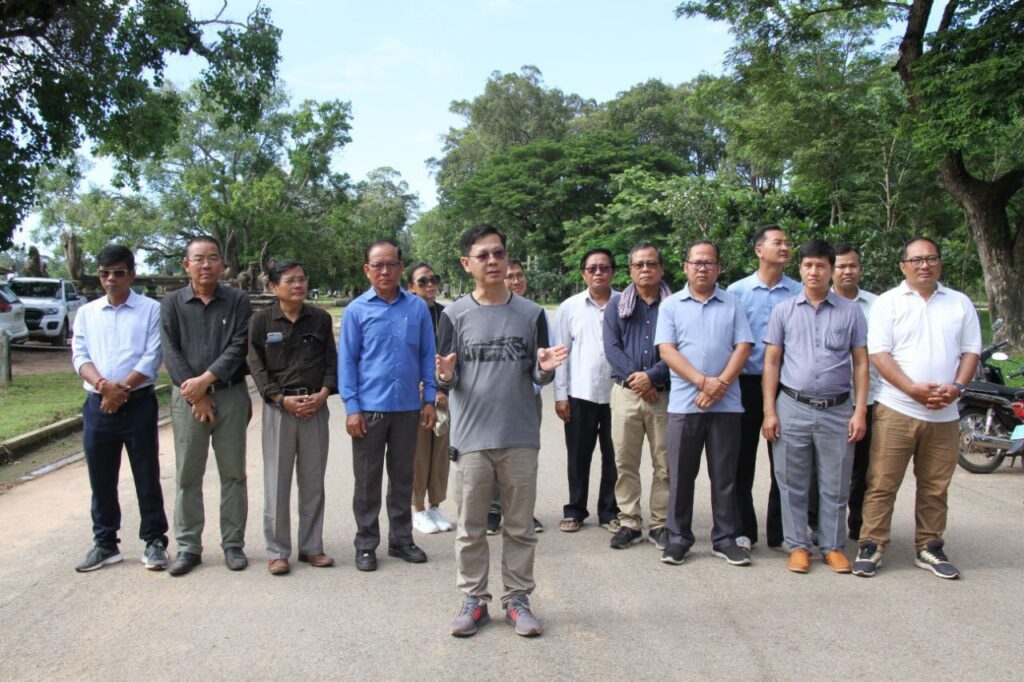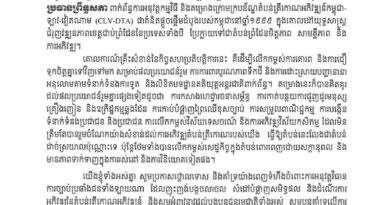កូនឈើចម្រុះចំនួន១២០០ដើម និងស្មៅចំនួន៤០០ម៉ែត្រការរ៉េ ត្រូវបានដំាដុះនៅលើផ្ទៃដីចំនួនកន្លះហិកតា នាបរិវេណខាងមុខប្រាសាទអង្គរវត្ត ក្បែស្រះត្រពាំងសេស។
នៅព្រឹកថ្ងៃទី១៦ ខែសីហា ឆ្នាំ២០២៣នេះ ឯកឧត្តមបណ្ឌិត ហង់ ពៅ អគ្គនាយក រួមទាំងអគ្គនាយករង ប្រធាននាយកដ្ឋាន អនុប្រធាន ព្រមទាំងមន្ត្រី បុគ្គលិក នាយកដ្ឋានចំណុះនៃអាជ្ញាធរជាតិអប្សរា ប្រមាណ៥០០នាក់ បានរួមគ្នាដាំកូនឈើចម្រុះចំនួន១,២០០ដើម និងស្មៅចំនួន៤០០ម៉ែត្រការរ៉េ នៅបរិវេណខាងមុខប្រាសាទអង្គរវត្ត ក្បែស្រះទឹកត្រពាំងសេស។
ឯកឧត្តមបណ្ឌិត ហង់ ពៅ អគ្គនាយកអាជ្ញាធរជាតិអប្សរា មានប្រសាសន៍ក្នុងឱកាសនោះថា ក្រោយការបង្កើតឱ្យមាននាយកដ្ឋានគ្រប់គ្រងទឹកនិងព្រៃឈើ នាអំឡុងឆ្នាំ២០០៤មក នាយកដ្ឋាននេះបានរៀបចំផែនការធ្វើយ៉ាងណាឱ្យតំបន់រមណីយដ្ឋានអង្គរ មានដើមឈើកាន់តែច្រើន។ ដោយក្នុងរយៈពេល១៩ឆ្នាំកន្លងមកនេះ ដើមឈើសរុបប្រមាណ២លានដើមហើយ ត្រូវបានដាំដុះនៅក្នុងតំបន់អង្គរ នេះមិនបានរាប់បញ្ជូលការចែកចាយកូនឈើ ទៅកាន់ស្ថាប័នរដ្ឋ និងឯកជនឡើយ។ ឯកឧត្តមបានបញ្ជាក់ទៀតថា នៅក្នុងឆ្នាំ២០២២ និងឆ្នាំ២០២៣នេះ ក្រោយការសម្រេចរបស់រាជរដ្ឋាភិបាល ក្នុងការរៀបចំឡើងវិញនៅក្នុងតំបន់អង្គរ ដោះស្រាយនូវបញ្ហាផលប៉ះពាល់ទេសភាពវប្បធម៌ និងតម្លៃជាសកលរបស់អង្គរ ទើបអាជ្ញាធរជាតិអប្សរា មានឱកាស ដើម្បីបង្កើនការថែទាំនិងលើកតម្លៃតំបន់រមណីយដ្ឋានអង្គរ។ ក្នុងនោះចាប់ពីអំឡុងចុងឆ្នាំ២០២២ មកដល់បច្ចុប្បន្ន កូនឈើចម្រុះចំនួនជាង៤៧,០០០ដើម ត្រូវបានដំាដុះយ៉ាងឆាប់រហ័ស លើផ្ទៃដីទំនេរ នៅជុំវិញតំបន់អង្គរ។
ឯកឧត្តម បានគូសបញ្ជាក់បន្ថែមអំពីអត្ថប្រយោជន៍ជាច្រើនរបស់ដើមឈើ ជាពិសេសសម្រាប់ប្រាសាទបុរាណ ក្នុងនោះធាតុបីដែលមិនអាចចែកដាច់ពីគ្នាបាន រួមមាន៖ ទឹក ព្រៃឈើ និងប្រាសាទ។ ដូចយើងដឹងហើយថា ស្ថេរភាពរបស់ប្រាសាទ ត្រូវមានទំនាក់ទំនងនឹងទឹកក្រោមដី ដូច្នេះបើសិនជាយើងដាំដើមឈើ ដើមឈើទាំងនោះនឹងជួយកាត់បន្ថយភាពរំហួតនៃទឹកនៅក្រោមដី។ ក្នុងនោះដើមឈើ ដុះនៅជិតប្រាសាទ នឹងបញ្ចេញសំណើម ធ្វើរស្មីសំយោគ ជួយកាត់បន្ថយកម្តៅនៃប្រាសាទ ជាហេតុនាំឱ្យថ្មមិនងាយនិងប្រះ ឬរលំ ឬភាពសិករិករឹលនៃប្រាសាទ។ មួយវិញទៀត ព្រៃឈើ នឹងជួយកាត់បន្ថយល្បឿនខ្យល់ ដែលអាចមានផលប៉ះពាល់ទៅដល់ប្រាសាទបុរាណផងដែរ។
ឯកឧត្តមអគ្គនាយក មានប្រសាន៍បន្ថែមទៀតថា ទីតាំងដែលបានដាំស្មៅ និងកូនឈើឡើងវិញនេះ ជាទីតាំងល្អបំផុតនៅបរិវេណខាងមុខប្រាសាទអង្គរ ព្រោះទីនេះកន្លងមកជាកន្លែងដែលអាជ្ញាធរជាតិអប្សរា រៀបចំជាសំណង់សម្រាប់ដាក់សម្ភារៈ ដើម្បីបម្រើការងារជួសជុលស្ពានហាល និងការប្រើប្រាស់ផ្សេងៗ។
អាជ្ញាធរជាតិអប្សរា មានក្តីសង្ឈឹមថា ពីមួយថ្ងៃទៅមួយថ្ងៃ តំបន់អង្គរ នឹងកាន់តែមានភាពស្រស់បំព្រង ពោពេញទៅដោយព្រៃឈើ មានលក្ខណៈលម្អដល់ប្រាសាទ និងបន្ថែមគុណភាពនៃជីវិត សម្រាប់ភ្ញៀវទេសចរដែលចូលមកទស្សនាតំបន់រមណីយដ្ឋានអង្គរ៕
អត្ថបទ៖នាយកដ្ឋាន ស្រាវជ្រាវ បណ្តុះបណ្តាល និងផ្សព្វផ្សាយ
រូបភាព៖លោក ហាប់ គឹមអាន ,លោកហ៊ុ រិទ្ធី និងលោកភោគ ជា
APSARA National Authority to plant more trees and grass in front of the Angkor temple
On 16 August 2023, H.E. Dr. Hang Peou, Director General of APSARA National Authority, Deputy Director Generals, Department Directors, Department Deputy Director, and about 500 staff of the APSARA National Authority planted 1,200 mixed trees and 400 square meters of grass in front of the Angkor Wat temple near the Trapeang Ses.
H.E. Dr. Hang Peou said on that occasion that after the establishment of the Department of Water and Forestry Management in 2004, this department has made plans to make the Angkor area have more trees. In the past 19 years, a total of 2 million trees have been planted in the Angkor area, not including the distribution of seedlings to public and private institutions. He added that in 2022 and 2023, after the decision of the Royal Government to reorganize the Angkor area to address the impact of the cultural landscape and outstanding universal values of Angkor, the APSARA National Authority has the opportunity to increase the maintenance and enhance of the Angkor site. From the end of 2022 to the present, more than 47,000 mixed trees have been rapidly planted on vacant land around Angkor.
He further highlighted the many benefits of trees, especially for ancient temples, including the three inseparable elements: water, forest, and temple. As we all know, the stability of a temple is related to groundwater, so if we plant trees, those trees will help reduce the evaporation of groundwater. The trees growing near the temple will release moisture, and reduce the heat of the temple causing the stone to crack, collapse, or erosion of the temple. On the other hand, the trees will help reduce wind speed, which can affect the ancient temples as well.
APSARA National Authority hopes that day by day, the Angkor area will be more beautiful, full of forests, beautify the temple and increase the quality of life for tourists who visit the Angkor area.
Article: Department of Research, Training, and Communication
Photos: Hab Kim An, Hum Rithy, and Phouk Chea





